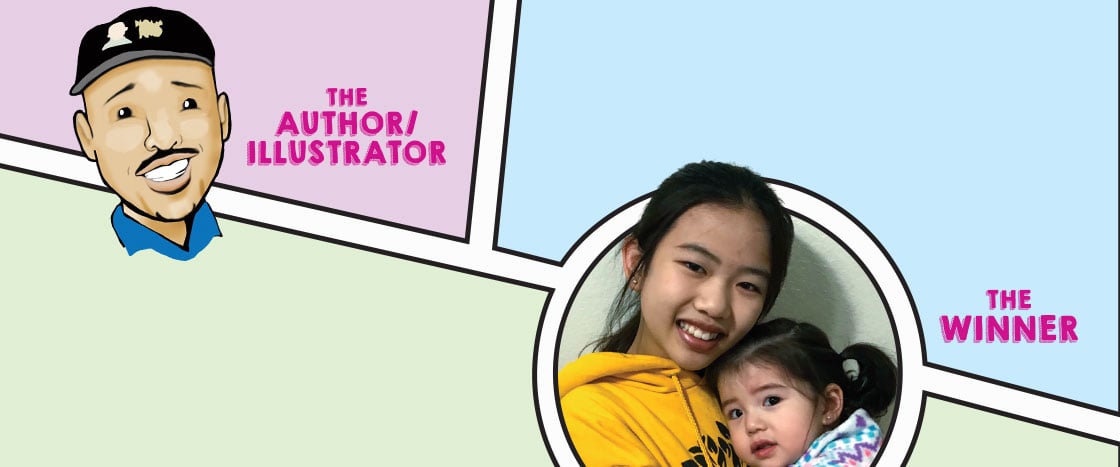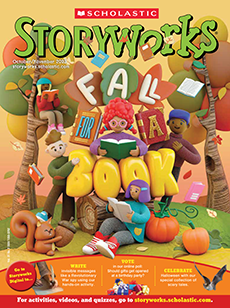Want to hear this story read aloud by a Storyworks writer? Find the audio read-aloud in your Resources tab.

Create a Character Contest Winner / A Recipe For Disaster
We received 1,340 entries for this year’s create a character contest!
Learning Objective: Students will make inferences about character, using both words and images in a graphic novel-style story.
Standards
1. Preparing to Read
Introduce the Story (5 minutes)
- We are thrilled to be offering for the very first time in Storyworks a graphic novel-style story, the outcome of our Create a Character contest. Newbery Medal winner Jerry Craft wrote and drew the story, based on a character described by 11-year-old Naomi Li. Ask students to turn to page 15 to meet this talented team.
Set a Purpose for Reading (5 minutes)
- Graphic novels have been used in the classroom increasingly over the past decade. Like traditional prose, they offer opportunities to think about literary elements like character, plot, and theme. The visual presentation can make a story more accessible and engaging, while also challenging readers to make inferences based on what they see—or don’t see. Our Can’t Miss Teaching Extras, at Storyworks Digital, provide links to resources for teaching graphic novels.
- As students read, prompt them to look for how the main character, Elizabeth, feels, based on both the words and pictures.
Vocabulary (10 minutes)
- This story revolves around a girl’s struggle to choose one dish that represents her mixed heritage. On page 16, her classmates share the names of dishes they will bring to a class celebration. Our vocabulary Skill Builder will help students explore these dishes and where they come from.
2. Reading and Discussing
- Have students read the article in the magazine or digitally. They can also listen to our special Immersive Read-Aloud with author Kristin Lewis.
- Put students in groups, either in your classroom or in virtual breakout rooms. Ask them to read the article a second time and discuss or write their answers to the close-reading questions and critical-thinking questions.
SEL Focus
Perseverance
Hunter’s story is a great example of perseverance. As a class, discuss what Hunter aimed to do, the obstacles he faced, and how he reacted to these obstacles. Then ask: Why was Hunter’s mission so important to him? Is there an issue that’s important to you? What can you learn from Hunter about how you could address that issue? Invite students to share their ideas, then challenge them to put them into action!
Close-Reading Questions
- In the frame at the bottom of page 16, how do you think Elizabeth feels? How does the drawing help you infer this? (inference/ visual literacy) Elizabeth probably feels stressed and confused. In the picture, her face looks sad and she appears to be thinking. Her classmates’ words are surrounding her head, so it looks like what they’re saying is adding to her stress.
- Look at the dishes kids say they will bring to the class celebration. Which ones are you familiar with? Where does each one typically come from? (vocabulary) Answers will vary for the first question. Dishes include kimchi and BBQ beef (Korea), jerk chicken (Jamaica), borscht (Russia), soda bread (Ireland), corn bread (the South), and yakitori (Japan).
- On page 17, what do you find out is Elizabeth’s main problem? (identifying a problem) Elizabeth doesn’t know what dish to bring to represent her heritage because she has two. Her mom is Chinese American and her dad is Mexican American. She doesn’t want to hurt either one by choosing a favorite recipe from the other’s culture.
- Based on pages 18 and 19, what are Liz’s parents like? (character) They are positive and supportive of Liz and of each other. Her dad tells her “it’s a blessing to have two amazing family traditions,” and each parent encourages her to pick the other’s special dish. In the images, they look friendly.
- Look at the frames on pages 19-20 that are labeled “Friday night” through “Sunday afternoon.” What story do they tell? (visual literacy) They tell the story of Liz worrying all weekend about what to do. She thinks about what dish to bring while she’s in bed, playing soccer, and sitting around her house. Finally, she has a great idea.
- How does Liz finally solve her problem? (problem and solution) With her parents’ help, she creates a dish that represents both her Chinese and Mexican heritages. She combines burritos and wontons to make . . . burri-tons!
Critical-Thinking Question
- If you were in Liz’s class, what dish, or combination of dishes, would you make? Explain why you would pick this. (making connections) Answers will vary.
- What do you think you get out of this story that you wouldn’t get if it were a traditional written story instead of a graphic one? (evaluating) Answers will vary. Students may say that they get to see the characters and understand what they’re thinking and doing based on their facial expressions and body movements. The settings can be understood without reading descriptions of them. Also, students might note that they’re able to read this story faster than a traditional one.
- What important ideas do you think the author—and character creator—want you to learn from this story? (theme) They probably want you to learn to be proud of your heritage, and that having two can be even better than having one! Furthermore, they might want you to realize that sometimes problems can feel overwhelming but that you can almost always find a solution.
3. Skill Building and Writing
- As a class, look at the writing prompt in the Write to Win box. Discuss what the words perseverance and empathy mean or review strategies for students to find out what they mean.
- Distribute or assign the Main Ideas and Supporting Details Slide Deck.
4. Digital Spotlight
- In this issue we are debuting our brand-new Immersive Read-Aloud. In this special audio feature, Kristin Lewis will read her article as music and sound effects make the story even more dramatic and gripping for listeners. Whether students are at home or in class, this exciting new feature will increase their engagement level!
This graphic format can be ideal for struggling readers. They can practice comprehension skills with the support of visual cues and minimal text. Guide them to complete the Skill Builders in our Core Skills Workout.
Invite students to rewrite this story as a traditional narrative, adding descriptive passages to replace the images. Alternatively, divide students into groups and ask each group to rewrite one part of the story as a narrative.
Before reading, review vocabulary words that might be challenging for ELL students; for example, represents, heritage, specialty, generations, and recipes. After reading, have students discuss whether they think Liz found a good solution.
If students enjoyed this story, invite them to read Jerry Craft’s award-winning graphic novel, New Kid. It’s about an African American boy who attends a prestigious private school and must navigate being one of the few kids of color there.
This article from Scholastic News 5/6 describes the discovery of the sunken Indianapolis in August 2017. Ask students what new information they learn from the article and what information can be found in both.
The National Museum of the U.S. Navy has a large collection of vintage photos of the Indianapolis, which had a storied history before it sank. Share photos of the Indianapolis sailing past the Statue of Liberty and the Golden Gate Bridge with students to give them a sense of the ship’s majesty and scale.
Bring students on an expedition of the Indianapolis wreckage in this PBS NewsHour video. You can have students compare its discovery to that of the Titanic, described in our September 2020 article “Searching for the Titanic.”
